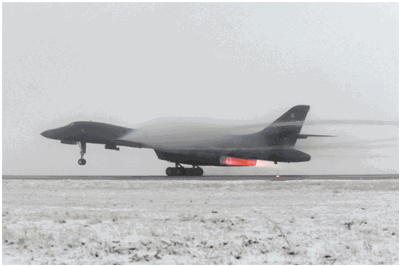Four B-1B Lancer Bombers Supported Operation Odyssey Dawn
Five years ago, a phone rang in the 28th Bomb Wing vice commander's office and made history.

Less than 72 hours later, on March 27, 2011, more than 1,100 maintenance personnel launched four B-1B Lancer bombers from the Ellsworth Air Force Base flightline in blizzard conditions to support Operation Odyssey Dawn. It was the first time the aircraft had ever launched from a continental U.S. location in support of combat operations.
Two B-1s and their eight-person crew would continue on and strike targets in Libya; however, the mission required communication and personnel working round-the-clock to be executed.
"I was about halfway through the planning process (of a training sortie), and rumors were making their way around about base leadership convening at the command post," said Maj. Matthew, a weapons system officer for the operation's lead B-1. "At about 1 p.m., I was called to the command post with a pilot in my squadron. We were both qualified mission commanders, which clued me in that whatever was going on was likely a real-world event."
Matthew and many aviators within the 34th and 37th bomb squadrons, as well as maintenance and munitions personnel, were briefed that preparations were underway to organize a strike mission more than 6,000 miles away in Libya.
In less than 20 hours, the conventional munitions element built approximately 145 munitions, enough to load seven B-1s. On the aviation side of the base, aircrews were preparing for takeoff.
"We had the pre-brief, and flew a practice profile in the simulator as well to make sure everyone on the crew had the opportunity to practice the bomb runs," said Maj. Christopher, co-pilot for the operation's lead B-1. "The biggest thing going through my mind was trying to absorb every bit of information so that we didn't mess it up."
This specific weapons build was the first time many had ever built bombs that would leave a CONUS location to bomb targets.
"Seeing these guys doing their job for real, I was proud of them. I couldn't have asked for a better crew at the time," said Master Sgt. Matthew, the 28th Munitions Squadron munitions control section chief.
Maintenance personnel and aircrew were executing their duties in the worst imaginable weather. It was roughly 35 degrees outside with heavy fog and pilots on the runway could only see ahead one hash-mark.
Maj. Brian, a weapons system officer for the operation's lead B-1, confessed to slipping multiple times on his way to transportation vehicles, while Maj. Matthew added the most memorable part of the mission was takeoff.
Brian said it was an honor to be selected as one of the crew members, and that he felt it was his duty to reward the faith previous commanders put in him by executing the mission to a weapons officer level.
B-1s arrived in the Libya area of operations 12 hours after takeoff and the crews checked in with command and control. Many aspects had changed between pre-brief and check-in, but the crews divvied up targets and went in for their first strike.
"The mission was the deepest strike made into Libya during OOD, which kept us in hostile airspace for over an hour and a half," Maj. Matthew said. "(Previous missile strikes) alerted the enemy to our presence, and we immediately saw anti-aircraft artillery fire coming from the ground. It was the first time any of us had seen AAA."

Poorly aimed artillery fire didn't concern the aviators, who hit their marks and recovered at a forward operating location. Twenty-four hours later, the second launch began. Nearly 100 targets were hit during the two days.
At only 72 hours, the mission marked a significant milestone, not only for Ellsworth AFB, but also for the B-1 fleet as a whole.
Maj. Matthew added the mission solidified the B-1 and its aircrew members' role as a flexible, rapidly-deployable strategic asset. Brian agreed that it showed the skill, dedication and professionalism of the 28th Maintenance Group.
"The fact they were able to generate five green jets, build 145 munitions, all while in the middle of a snow storm on only two days' notice still amazes me to this day," Brian said. "We train every day to do precisely that, but the maintainers and weapons troops can't simulate extreme weather and harsh temperatures. They were the MVPs of Odyssey Dawn in my opinion."
Master Sgt. Matthew, who led the munitions crew, added the lessons learned from the operation are always an example he brings up when training his fellow munitions Airmen.
"It's hard to overstate how important the ground support teams were to our success," Maj. Matthew said. "Without all of the support agencies, from maintenance to airfield operations, transportation, etc., we wouldn't have been nearly as successful."
According to mission planners, the B-1 was the only aircraft that could meet the demands of the mission, such as the timeframe and the number of weapons required to hit that many targets.
"Executing the strike proved the aircraft is capable of holding any target in the world at risk, at any time," said Maj. Donavon, commander of the operation's lead B-1.
(Editor’s note: Last names were removed due to security concerns.)
(Image provide with USAF news release)
 Aero-News: Quote of the Day (05.09.24)
Aero-News: Quote of the Day (05.09.24) ANN's Daily Aero-Term (05.09.24): Hold Procedure
ANN's Daily Aero-Term (05.09.24): Hold Procedure ANN's Daily Aero-Linx (05.09.24)
ANN's Daily Aero-Linx (05.09.24) Airborne 05.03.24: Advanced Powerplant Solutions, PRA Runway Woes, Drone Racing
Airborne 05.03.24: Advanced Powerplant Solutions, PRA Runway Woes, Drone Racing Airborne-NextGen 05.07.24: AI-Piloted F-16, AgEagle, 1st 2 WorldView Sats
Airborne-NextGen 05.07.24: AI-Piloted F-16, AgEagle, 1st 2 WorldView Sats




